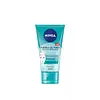What's inside
What's inside
 Key Ingredients
Key Ingredients

 Benefits
Benefits

 Concerns
Concerns

 Ingredients Side-by-side
Ingredients Side-by-side

Water
Skin ConditioningGlycerin
HumectantXanthan Gum
EmulsifyingSodium Laureth Sulfate
CleansingCoco-Glucoside
CleansingFucus Vesiculosus Extract
EmollientTocopheryl Acetate
AntioxidantRetinyl Palmitate
Skin ConditioningCitric Acid
BufferingMicrocrystalline Cellulose
AbsorbentCellulose
AbsorbentHydroxypropyl Methylcellulose
Emulsion StabilisingKaolin
AbrasiveSilica
AbrasiveCaprylic/Capric Triglyceride
MaskingCaprylic/Capric Glycerides
EmollientLactose
HumectantSodium Hydroxide
BufferingSodium Sulfate
Sodium Chloride
MaskingSodium Benzoate
MaskingParfum
MaskingCI 77007
Cosmetic ColorantCI 42090
Cosmetic ColorantCI 47005
Cosmetic ColorantWater, Glycerin, Xanthan Gum, Sodium Laureth Sulfate, Coco-Glucoside, Fucus Vesiculosus Extract, Tocopheryl Acetate, Retinyl Palmitate, Citric Acid, Microcrystalline Cellulose, Cellulose, Hydroxypropyl Methylcellulose, Kaolin, Silica, Caprylic/Capric Triglyceride, Caprylic/Capric Glycerides, Lactose, Sodium Hydroxide, Sodium Sulfate, Sodium Chloride, Sodium Benzoate, Parfum, CI 77007, CI 42090, CI 47005
Water
Skin ConditioningCocamidopropyl Betaine
CleansingSodium Myreth Sulfate
CleansingAcrylates Copolymer
Magnolia Officinalis Bark Extract
AntimicrobialLactic Acid
BufferingGlycerin
HumectantLauryl Glucoside
CleansingSodium Lauryl Sulfate
CleansingPEG-40 Hydrogenated Castor Oil
EmulsifyingPEG-200 Hydrogenated Glyceryl Palmate
CleansingBenzophenone-4
UV AbsorberSodium Chloride
MaskingMicrocrystalline Cellulose
AbsorbentMannitol
HumectantPolyquaternium-10
Sodium Hydroxide
BufferingTrisodium EDTA
Phenoxyethanol
PreservativeMethylparaben
PreservativeEthylparaben
PreservativeCitronellol
PerfumingAlpha-Isomethyl Ionone
PerfumingParfum
MaskingCI 74160
Cosmetic ColorantCI 42090
Cosmetic ColorantWater, Cocamidopropyl Betaine, Sodium Myreth Sulfate, Acrylates Copolymer, Magnolia Officinalis Bark Extract, Lactic Acid, Glycerin, Lauryl Glucoside, Sodium Lauryl Sulfate, PEG-40 Hydrogenated Castor Oil, PEG-200 Hydrogenated Glyceryl Palmate, Benzophenone-4, Sodium Chloride, Microcrystalline Cellulose, Mannitol, Polyquaternium-10, Sodium Hydroxide, Trisodium EDTA, Phenoxyethanol, Methylparaben, Ethylparaben, Citronellol, Alpha-Isomethyl Ionone, Parfum, CI 74160, CI 42090
Ingredients Explained
These ingredients are found in both products.
Ingredients higher up in an ingredient list are typically present in a larger amount.
Ci 42090 is a synthetic dye created from petroleum. It is used to give a bright blue color to cosmetics, medicine, and food.
Glycerin is already naturally found in your skin. It helps moisturize and protect your skin.
A study from 2016 found glycerin to be more effective as a humectant than AHAs and hyaluronic acid.
As a humectant, it helps the skin stay hydrated by pulling moisture to your skin. The low molecular weight of glycerin allows it to pull moisture into the deeper layers of your skin.
Hydrated skin improves your skin barrier; Your skin barrier helps protect against irritants and bacteria.
Glycerin has also been found to have antimicrobial and antiviral properties. Due to these properties, glycerin is often used in wound and burn treatments.
In cosmetics, glycerin is usually derived from plants such as soybean or palm. However, it can also be sourced from animals, such as tallow or animal fat.
This ingredient is organic, colorless, odorless, and non-toxic.
Glycerin is the name for this ingredient in American English. British English uses Glycerol/Glycerine.
Learn more about GlycerinMicrocrystalline Cellulose is another name for refined wood pulp. It is used as an emulsifier and mattifying ingredient. As an emulsifier, it helps keep ingredients together.
Parfum is a catch-all term for an ingredient or more that is used to give a scent to products.
Also called "fragrance", this ingredient can be a blend of hundreds of chemicals or plant oils. This means every product with "fragrance" or "parfum" in the ingredients list is a different mixture.
For instance, Habanolide is a proprietary trade name for a specific aroma chemical. When used as a fragrance ingredient in cosmetics, most aroma chemicals fall under the broad labeling category of “FRAGRANCE” or “PARFUM” according to EU and US regulations.
The term 'parfum' or 'fragrance' is not regulated in many countries. In many cases, it is up to the brand to define this term.
For instance, many brands choose to label themselves as "fragrance-free" because they are not using synthetic fragrances. However, their products may still contain ingredients such as essential oils that are considered a fragrance by INCI standards.
One example is Calendula flower extract. Calendula is an essential oil that still imparts a scent or 'fragrance'.
Depending on the blend, the ingredients in the mixture can cause allergies and sensitivities on the skin. Some ingredients that are known EU allergens include linalool and citronellol.
Parfum can also be used to mask or cover an unpleasant scent.
The bottom line is: not all fragrances/parfum/ingredients are created equally. If you are worried about fragrances, we recommend taking a closer look at an ingredient. And of course, we always recommend speaking with a professional.
Learn more about ParfumChances are, you eat sodium chloride every day. Sodium Chloride is also known as table salt.
This ingredient has many purposes in skincare: thickener, emulsifier, and exfoliator.
You'll most likely find this ingredient in cleansers where it is used to create a gel-like texture. As an emulsifier, it also prevents ingredients from separating.
There is much debate on whether this ingredient is comedogenic. The short answer - comedogenic ratings don't tell the whole story. Learn more about comegodenic ratings here.
The concensus about this ingredient causing acne seems to be divided. Research is needed to understand if this ingredient does cause acne.
Scrubs may use salt as the primary exfoliating ingredient.
Learn more about Sodium ChlorideSodium Hydroxide is also known as lye or caustic soda. It is used to adjust the pH of products; many ingredients require a specific pH to be effective.
In small amounts, sodium hydroxide is considered safe to use. However, large amounts may cause chemical burns due to its high alkaline.
Your skin has a natural pH and acid mantle. This acid mantle helps prevent harmful bacteria from breaking through. The acid mantle also helps keep your skin hydrated.
"Alkaline" refers to a high pH level. A low pH level would be considered acidic.
Learn more about Sodium HydroxideWater. It's the most common cosmetic ingredient of all. You'll usually see it at the top of ingredient lists, meaning that it makes up the largest part of the product.
So why is it so popular? Water most often acts as a solvent - this means that it helps dissolve other ingredients into the formulation.
You'll also recognize water as that liquid we all need to stay alive. If you see this, drink a glass of water. Stay hydrated!
Learn more about Water